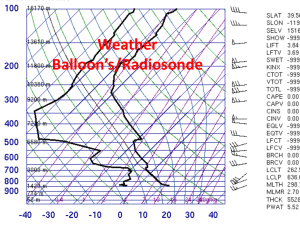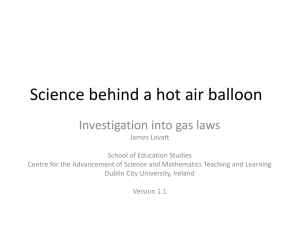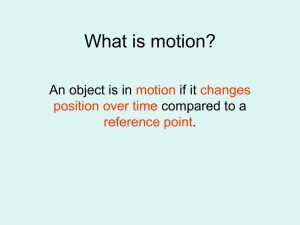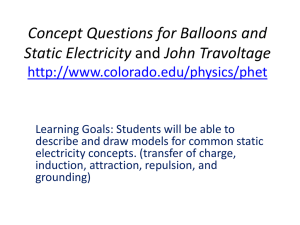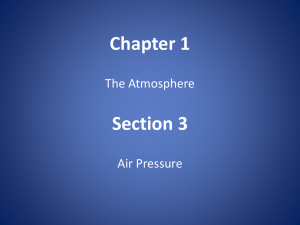Lecture 7
advertisement
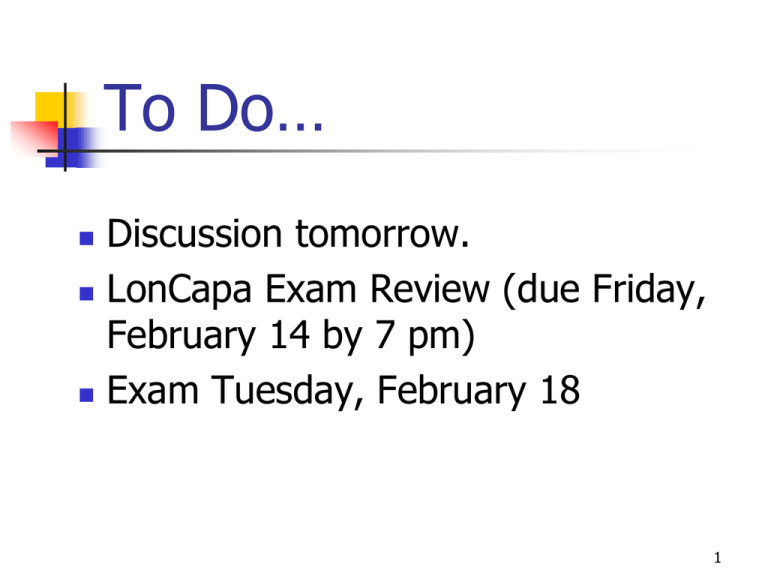
To Do… Discussion tomorrow. LonCapa Exam Review (due Friday, February 14 by 7 pm) Exam Tuesday, February 18 1 Exam 1 Tuesday, February 18; 7:00 pm – 8:30 pm; 114 David Kinley Hall (DKH) Conflict: 2/18; 5:00 pm – 6:30 pm; 140 Burrill (sign up outside of 101 CA) All free response. See me right away if you have a conflict with the exam and conflict times. 2 Exam 1 Reviews Saturday, 2/15, 140 Burrill Hall, 1:002:50 pm (Tracey and Jonathan) Sunday, 2/16, 161 Noyes Lab; 4:005:20 pm (Ryan and Ina) 3 Egg in a Bottle Using liquid nitrogen to cool the bottle. What factors are changing? What factors are staying constant? Placing a flame in the bottle. What factors are changing? What factors are staying constant? 4 Clicker Question You are holding three balloons each containing an equal mass of a different gas. The balloon containing which gas is the largest balloon? a) H2 b) He c) O2 d) All have the same volume. 5 Clicker Question You are holding three balloons each containing an equal mass of a different gas. The balloon containing which gas is the largest balloon? a) H2 b) He c) O2 d) All have the same volume. 6 Clicker Question You are holding two 4.50-L balloons, one with helium gas and one with SF6 gas, both at 1.00 atm and 25°C. In which balloon is there a greater number of moles of gas? a) The balloon filled with helium gas. b) The balloon filled with SF6 gas. c) The balloons contain an equal number of moles of gas. 7 Clicker Question You are holding two 4.50-L balloons, one with helium gas and one with SF6 gas, both at 1.00 atm and 25°C. In which balloon is there a greater number of moles of gas? a) The balloon filled with helium gas. b) The balloon filled with SF6 gas. c) The balloons contain an equal number of moles of gas. 8 Clicker Question You are holding two 4.50-L balloons, one with helium gas and one with SF6 gas, both at 1.00 atm and 25°C. In which balloon is there a greater mass of gas? a) The balloon filled with helium gas. b) The balloon filled with SF6 gas. c) The balloons contain an equal mass of gas. 9 Clicker Question You are holding two 4.50-L balloons, one with helium gas and one with SF6 gas, both at 1.00 atm and 25°C. In which balloon is there a greater mass of gas? a) The balloon filled with helium gas. b) The balloon filled with SF6 gas. c) The balloons contain an equal mass of gas. 10 Gas Law Problems You are holding two 4.50-L balloons, one with helium gas and one with SF6 gas, both at 1.00 atm and 25°C. Determine the number of moles of each gas. (0.184 mol) Determine the mass of each gas. (26.9 g SF6, 0.736 g He) 11 Gas Law Problem What happens to a 4.50-L balloon at 25.0C and 1.00 atm if you heat it to 95.5C ? Solve for the new condition. (V2=5.56L) 12 Gas Law Problem What happens to a 4.50-L steel tank of gas at 25.0C and 1.00 atm if you heat it to 95.5C ? Solve for the new condition. (P2=1.24 atm) 13 Clicker Question You have a certain mass of He gas in a rigid steel container. You add the same mass of Ne gas to this container at constant temperature. Which of the following best describes what happens? a) The pressure in the container doubles. b) The pressure in the container increases but the increase is less than double. c) The pressure in the container more than doubles. 14 Clicker Question You have a certain mass of He gas in a rigid steel container. You add the same mass of Ne gas to this container at constant temperature. Which of the following best describes what happens? a) The pressure in the container doubles. b) The pressure in the container increases but the increase is less than double. c) The pressure in the container more than doubles. 15 The Partial Pressure of each Gas in a Mixture of Gases in a Container Depends on the Number of Moles of that Gas Gas Law Problem Consider a sample of gas at 2.00 atm in a 35.0-L container at 25.0C . You transfer all of the gas to a 70.0-L container and you heat the gas to 50.0C. Determine the new pressure of the gas. (P2=1.08 atm) 17 Clicker Question As you increase the temperature of a sample of gas at constant pressure and volume, what happens to the number of moles of gas? a) The number of moles of gas increases. b) The number of moles of gas decreases. c) The number of moles of gas does not change. 18 Clicker Question As you increase the temperature of a sample of gas at constant pressure and volume, what happens to the number of moles of gas? a) The number of moles of gas increases. b) The number of moles of gas decreases. c) The number of moles of gas does not change. 19


